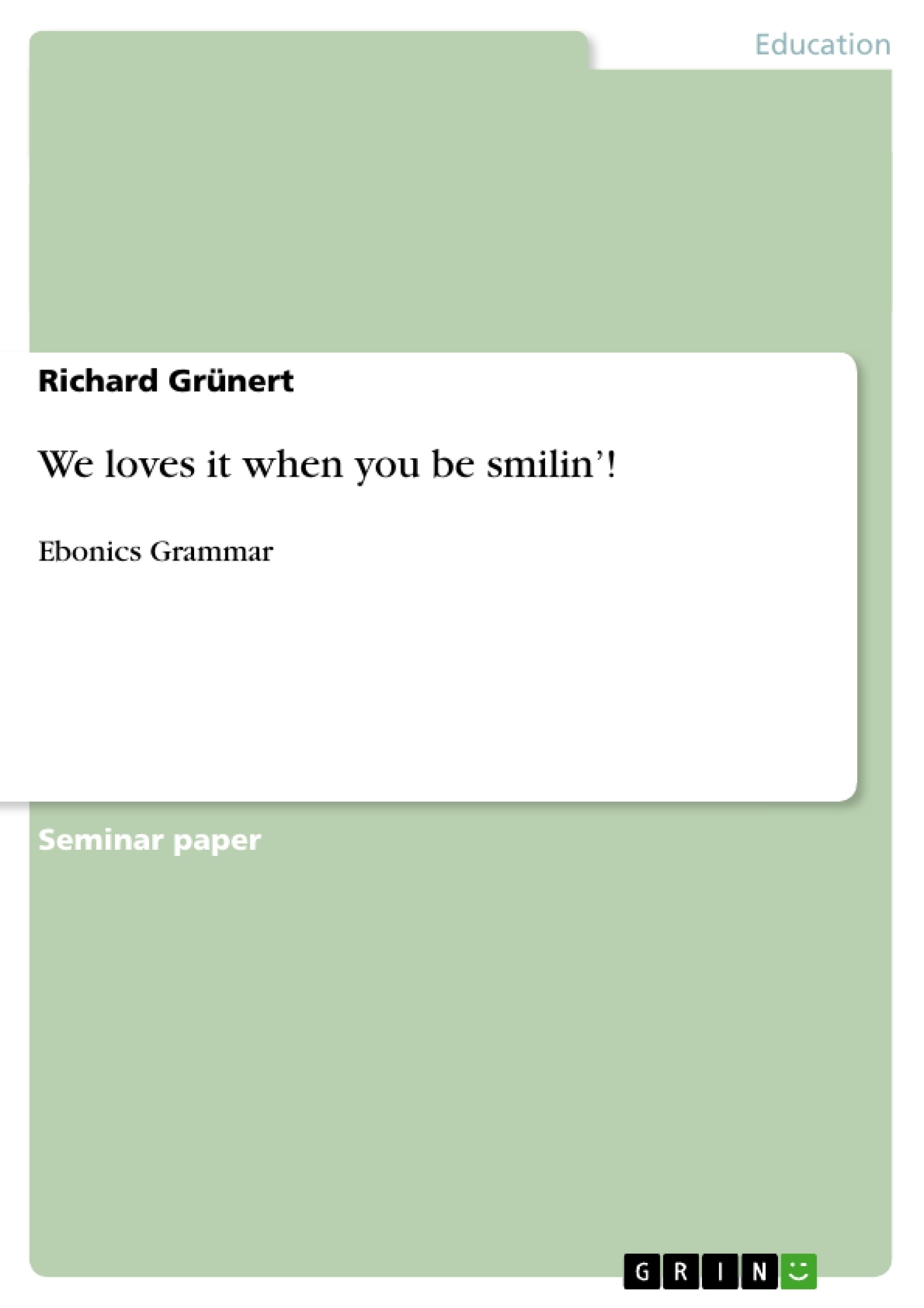Ebonics is probably the most popular and widespread linguistic phenomena in the world today. This is mainly due to the fact that American music is a worldwide predominant cultural reality. Black American music with its inherent linguistic characteristics, by the same token, looms large within that heritage. In this paper I will commence with a description of the term “Ebonics” and some information on the scientific state of affairs concerning its origins. Then I will proceed to some phonological aspects and conclude with a short look at its grammatical structure and idiosyncrasies. African-American English, the linguistic variety spoken by many African Americans in the United States of America, is a system with specific rules for combining sounds to form words, phrases and sentences. The first researchers who took an interest in this called it “Non-Standard Negro English”, “Negro dialect” or “American Negro speech”. However, because of the growing objections to the term Negro, other terms had to be found – parallel to the changes – in referring to black people. But even though the terms “African-American Vernacular English” (AAVE), “Black communications”, Black dialect”, “Black English”, “Black Vernacular English”, “African American language”, “African American English” and, as Stanford Afro-American Linguist John Baugh named it, “Black Street Speech” (Baugh, 1983: 11), have all been used to label this variety over the past forty years, the word “Ebonics” (a blend of ebony and phonetics that was created in 1973 by a group of black scholars) is probably the most popular one today. This essay is to be understood as a brief survey on its grammatical and linguistic features.
Inhaltsverzeichnis (Table of Contents)
- Introduction
- What is Ebonics anyway?
- Where does it come from?
- Language or dialect
- Phonology
- ...and how does it sound?
- The consonant system
- The r
- Reduction of word-final clusters
- Reductions on consonant combinations in the middle of words
- Auxiliaries
- The dental fricatives
- The lateral
- The vowel system
- Monophtongization
- Vowel shift
- Nasals
- Grammar
- The use of to be and its forms
- Tense peculiarities
- A note about done
- Epilogue
Zielsetzung und Themenschwerpunkte (Objectives and Key Themes)
This paper aims to provide a concise overview of Ebonics, a linguistic variety spoken by many African Americans in the United States. It delves into the origin and evolution of the term “Ebonics,” exploring the "dialectal hypothesis" and the "Creole hypothesis" regarding its roots. The paper further examines key phonological features, focusing on the consonant and vowel systems, and concludes with a brief exploration of grammatical peculiarities.
- Origins and evolution of the term "Ebonics" and its various labels
- The "dialectal hypothesis" and the "Creole hypothesis" concerning the origins of Ebonics
- Key phonological features of Ebonics, including the consonant and vowel systems
- Grammatical characteristics of Ebonics, such as the use of "to be" and tense peculiarities
- The broader cultural significance of Ebonics, particularly its presence in American music and culture
Zusammenfassung der Kapitel (Chapter Summaries)
The first chapter introduces the subject of Ebonics, highlighting its prominence in contemporary American music and culture. The second chapter discusses the term "Ebonics" itself, tracing its evolution from earlier labels and establishing its significance as a term representing African-American English. The third chapter explores the two main theories regarding the origins of Ebonics: the "dialectal hypothesis" and the "Creole hypothesis". The fourth chapter tackles the ongoing debate about whether Ebonics should be considered a language or a dialect, suggesting the use of the term "variety" to avoid this linguistic dilemma. The fifth chapter delves into the phonological characteristics of Ebonics, beginning with a discussion of its distinctive sound and intonation, followed by an analysis of its consonant and vowel systems.
Schlüsselwörter (Keywords)
This paper focuses on the linguistic features of Ebonics, examining its origins, phonology, and grammar. Key concepts explored include the "dialectal hypothesis," the "Creole hypothesis," African-American Vernacular English (AAVE), Black English, and Black Street Speech. The paper also discusses the significance of Ebonics in American music and culture.
- Citar trabajo
- Richard Grünert (Autor), 2009, We loves it when you be smilin’!, Múnich, GRIN Verlag, https://www.grin.com/document/129677



